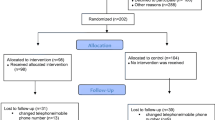Abstract
Introduction and hypothesis
Pregnant women benefit from completing pelvic floor muscle exercises (PFMEs). The aims of the study were to evaluate pregnant women’s levels of awareness, knowledge, and beliefs about the pelvic floor muscles (PFMs) and PFMEs.
Methods
A cross-sectional survey was conducted. Respondents were pregnant women over the age of 18 years who attended antenatal clinics in Western Australia (WA). Questionnaire items measured awareness and knowledge about PFMs, confidence and beliefs about engaging in PFMEs, and attendance at antenatal education (ANE) classes. Chi-squared tests examined potential associations between questionnaire items and respondent characteristics.
Results
Mean gestation of respondents (n = 633 out of 850; 74% response rate) was 28.7 (+7.8) weeks and 50% were giving birth for the first time. Although 76% of respondents knew that PFMs can prevent urinary incontinence, only 27% knew that they prevented faecal incontinence and 41% thought it was normal to leak urine when pregnant. Only n = 72 (11%) were practicing PFMEs. Respondents who had attended ANE (28%) were significantly more knowledgeable about pelvic floor function (p < .001) and significantly less likely to believe that leaking urine during pregnancy was normal (p = 0.02), compared with those who had not attended ANE. Respondents who did not speak English at home (18%) were significantly less knowledgeable about PFMs and PFMEs, and significantly less likely to have attended, or planned to attend, ANE classes.
Conclusion
Pregnant women require more health education regarding PFMs. Education should be provided using diverse modes, especially for women from migrant backgrounds and women who do not plan to attend formal ANE classes.


Similar content being viewed by others
References
Whitford HM, Alder B, Jones M. A cross-sectional study of knowledge and practice of pelvic floor exercises during pregnancy and associated symptoms of stress urinary incontinence in North-East Scotland. Midwifery. 2007;23:204–17. doi:10.1016/j.midw.2006.06.006.
Sangsawang B, Sangsawang N. Stress urinary incontinence in pregnant women: a review of prevalence, pathophysiology, and treatment. Int Urogynecol J. 2013;24:901–12. doi:10.1007/s00192-013-2061-7.
Rortveit G, Daltveit AK, Hannestad YS, Hunskaar S. Urinary incontinence after vaginal delivery or cesarean section. N Engl J Med. 2003;348:900–7. doi:10.1056/NEJMoa021788.
Lasserre A, Pelat C, Gueroult V, Hanslik T, Chartier-Kastler E, Blanchon T, et al. Urinary incontinence in French women: prevalence, risk factors, and impact on quality of life. Eur Urol. 2009;56:177–83. doi:10.1016/j.eururo.2009.04.006.
Memon H, Handa VL. Pelvic floor disorders following vaginal or cesarean delivery. Curr Opin Obstet Gynecol. 2012;24:349–54. doi:10.1097/GCO.0b013e328357628b.
Boyle R, Hay-Smith EJ, Cody JD, Morkved S. Pelvic floor muscle training for prevention and treatment of urinary and faecal incontinence in antenatal and postnatal women. Cochrane Database Syst Rev. 2012;10, Cd007471. doi:10.1002/14651858.CD007471.pub2.
Bo K, Hilde G. Does it work in the long term?—A systematic review on pelvic floor muscle training for female stress urinary incontinence. Neurourol Urodyn. 2013;32:215–23. doi:10.1002/nau.22292.
Michie S, van Stralen MM, West R. The behaviour change wheel: a new method for characterising and designing behaviour change interventions. Implement Sci. 2011;6:42. doi:10.1186/1748-5908-6-42.
Abraham C, Michie S. A taxonomy of behavior change techniques used in interventions. Health Psychol. 2008;27:379–87. doi:10.1037/0278-6133.27.3.379.
Cane J, O’Connor D, Michie S. Validation of the theoretical domains framework for use in behaviour change and implementation research. Implement Sci. 2012;7:37. doi:10.1186/1748-5908-7-37.
O’Neill AT, Hockey J, O’Brien P, Williams A, Morris TP, Khan T, et al. Knowledge of pelvic floor problems: a study of third trimester, primiparous women. Int Urogynecol J. 2017;28:125–9. doi:10.1007/s00192-016-3087-4.
Neels H, Wyndaele JJ, Tjalma WA, De Wachter S, Wyndaele M, Vermandel A. Knowledge of the pelvic floor in nulliparous women. J Phys Ther Sci. 2016;28:1524–33. doi:10.1589/jpts.28.1524.
Moossdorff-Steinhauser HF, Albers-Heitner P, Weemhoff M, Spaanderman ME, Nieman FH, Berghmans B. Factors influencing postpartum women’s willingness to participate in a preventive pelvic floor muscle training program: a web-based survey. Eur J Obstet Gynecol Reprod Biol. 2015;195:182–7. doi:10.1016/j.ejogrb.2015.10.009.
Hutchinson M, Joyce A. Western Australia’s mothers and babies, 2011: twenty-ninth annual report of the Western Australian midwives’ notification. Department of Health WA: Western Australia; 2014.
Australian Bureau of Statistics. Socio-Economic Indexes for Areas (SEIFA), 2011 Canberra: Commonwealth of Australia; 2013. http://www.abs.gov.au/websitedbs/censushome.nsf/home/seifa. Accessed 19 December 2016.
Portney LG, Watkins MP. Foundations of clinical research: applications to practice. 3rd ed. Philadephia: Davis; 2015.
Peat J, Williams K, Wei X, Mellis C. Health science research: a handbook of quantitative methods. London: Sage; 2002.
SurveyMonkey Inc. Palo Alto, California, USA. 2016. www.surveymonkey.com. Accessed 19 December 2016.
Creative research systems Sebastopol CA 2016. http://www.surveysystem.com/sscalc.htm. Accessed 19 December 2016.
Sangsawang B. Risk factors for the development of stress urinary incontinence during pregnancy in primigravidae: a review of the literature. Eur J Obstet Gynecol Reprod Biol. 2014;178:27–34. doi:10.1016/j.ejogrb.2014.04.010.
Wilson J, Berlach RG, Hill A-M. An audit of antenatal education facilitated by physiotherapists in Western Australian public hospitals. Aust N Z Continence J. 2014;20(2):44–6.
Whitford HM, Jones M. An exploration of the motivation of pregnant women to perform pelvic floor exercises using the revised theory of planned behaviour. Br J Health Psychol. 2011;16:761–78. doi:10.1111/j.2044-8287.2010.02013.x.
Ghaderi F, Oskouei AE. Physiotherapy for women with stress urinary incontinence: a review article. J Phys Ther Sci. 2014;26:1493–9. doi:10.1589/jpts.26.1493.
Australian Bureau of Statistics. 2012. http://www.abs.gov.au/websitedbs/censushome.nsf/home/CO-60. Accessed 19 December 2016.
Acknowledgements
Authors thank all pregnant women in WA who responded to the survey and the women’s health physiotherapists who gave input and feedback to the survey design.
Author information
Authors and Affiliations
Corresponding author
Ethics declarations
Funding
Nil.
Conflicts of interest
None.
Rights and permissions
About this article
Cite this article
Hill, AM., McPhail, S.M., Wilson, J.M. et al. Pregnant women’s awareness, knowledge and beliefs about pelvic floor muscles: a cross-sectional survey. Int Urogynecol J 28, 1557–1565 (2017). https://doi.org/10.1007/s00192-017-3309-4
Received:
Accepted:
Published:
Issue Date:
DOI: https://doi.org/10.1007/s00192-017-3309-4



